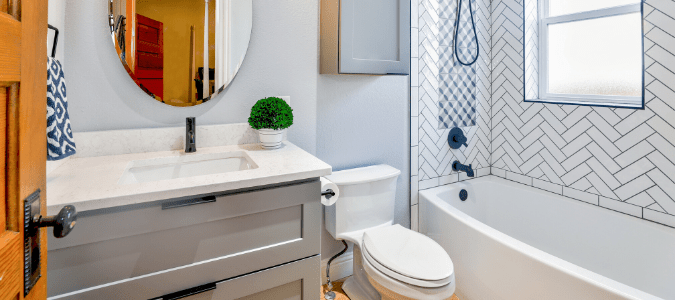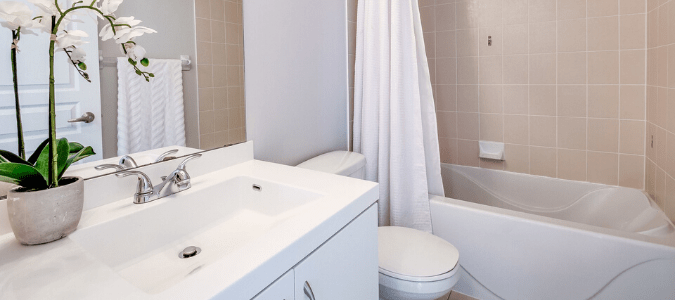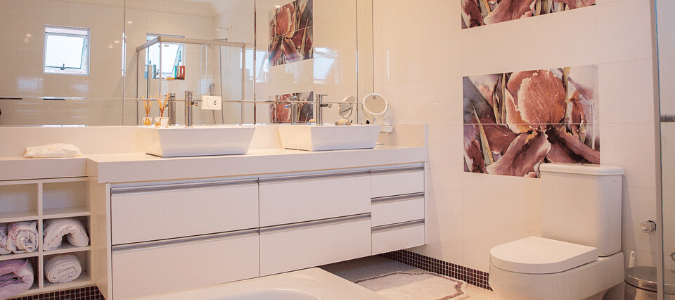It can be confusing to find your toilet tank not filling but water is running. Why wouldn’t the tank fill up when the water is running like it’s supposed to? This is a problem because when the tank doesn’t fill, the toilet can’t flush. If you live in a house with other people, that’s a situation that needs fixing fast. Fortunately, it can be easy to diagnose this type of problem if you have basic plumbing knowledge.
This problem could involve one or several different components. Here are the different components of your toilet that could malfunction and cause this problem.
The Water Supply Line
If there’s a leak in the water supply line that runs to your toilet, the tank will still fill, just slowly. If the leak isn’t fixed, however, the tank will start filling more and more slowly over time. This is something that a plumber should look at as soon as possible. Hidden leaks can cause damage to drywall, flooring and other structural elements. To make things worse, they can also cause high water bills.
Sometimes, clogs can develop in the water supply line, causing the toilet to fill slowly. To test this, turn off the water supply valve at the wall, usually located below the toilet tank. Once the water supply is off, you can disconnect the supply line at the toilet and point it into a bucket. Then, turn the water supply back on. If the water comes out in a trickle or not at all, there’s a good chance the line has a clog.
If there’s no clog, the issue could be a leak somewhere in the water supply line or in the pipes themselves. A plumber can perform a leak test and other diagnostic measures to determine what’s going on and how to fix it.
The Float
The float is the piece that’s attached to the fill valve inside the toilet tank. The float’s purpose is to keep the tank from overflowing when it fills up with water after a flush. When the float isn’t working right, the issue is usually that it’s set too low, so the tank isn’t able to fill up completely. Another sign your water level is too low is if your toilet won’t flush all the way.
Often, you can fix this by adjusting the float so the water level is high enough inside the tank after flushing. If you’re having difficulty adjusting the float, you can also replace it with a new one. As with other toilet problems, adjusting or replacing the float is an easy job for a plumbing professional.
The Fill Valve
The fill valve is inside the toilet tank, usually on the left side. It’s the part of the toilet that sends water back into the tank after flushing. When the fill valve isn’t working, it could have a blockage or it might be too old and worn out to work right. Fill valves also just break sometimes.
In any of these cases, the quickest and easiest fix is to replace the valve with a new one. This is another job that an experienced DIY homeowner can handle. However, if you attempt to fix this issue and find your toilet is overflowing at the tank, contact a plumber.
The Trip Assembly
The handle you use to flush your toilet is sometimes called a trip lever. The trip assembly is the part that’s inside the toilet tank, connected to the handle on the outside. If the trip assembly gets bent or broken, the toilet won’t flush properly. This means the tank also won’t fill properly after flushing.
Sometimes, you can fix a bent or broken trip assembly by bending it back into place. Other times, the chain connecting the trip assembly to the flapper breaks. This can be temporarily fixed with a paperclip.
Usually, though, the best thing to do with a broken trip assembly is to replace it with a new one. These parts are inexpensive and pretty simple for DIY types to replace themselves. Or, you can hire a plumber to do the job for you.
The Flapper
The flapper is the rubber mechanism at the bottom of the toilet tank that is pulled upward when you flush the toilet. The flapper lets water from the tank rush down into the toilet bowl, flushing the toilet. When the flapper settles back into place after flushing, it seals the tank once again, allowing it to refill with water.
If the flapper can’t create a good seal, the toilet tank won’t fill even if the water runs continuously. Conversely, if your flapper isn’t working, your toilet may flush twice. These things can happen because the flapper is old and misshapen or because the whole trip assembly isn’t working. When this happens, it means it’s time for a new flapper.
When you’re dealing with a toilet tank that won’t fill, even when the water is running, it can be hard to figure which toilet part is causing trouble. This is why it’s a good idea to contact a licensed specialist to diagnose and fix the plumbing problem. A reputable plumber can quickly and easily determine what’s going wrong and fix the issue. This will save you time, trouble and money in the long run. Having a toilet that runs without ever filling the tank or flushing properly can cost a lot of money in high water bills. Not to mention a lot of frustration at having a toilet that doesn’t work right.
How to Replace Toilet Float
There are two basic types of toilet floats, depending on what kind of toilet you have and how old it is. On older toilets, the float is a metal or plastic ball connected to a metal rod that is attached to the float valve. Newer toilets have plastic, cylindrical floats that are an integral part of the float valve. Whichever type of float your toilet has, it’s a relatively simple fix to handle yourself. If you know the right steps to follow, that is. Here are instructions for how to replace a toilet float yourself when yours goes bad.
Turn off The Water Supply
The first step before doing any type of toilet repair is to turn off the water supply to the toilet at the wall. There will be a valve below the toilet that you’ll turn all the way to the right (clockwise) to turn the water supply off.
Drain the Tank
Next, you’ll need to drain the tank by flushing the toilet, holding the handle down until all the water has drained out. If you’ve turned the water off properly, the tank will not refill after flushing. You may still have a small amount of water in the very bottom of the tank. You can get this out by soaking it up with towels or a sponge.
Remove the Float
Once the water supply is off and the tank is as empty of water as possible, it’s time to remove the old float. If your toilet is older and has the ball type of float, it’s very easy to remove. You just unscrew it from the float rod that it’s attached to. If you have a newer toilet equipped with an integral (plastic cylinder) float, the removal process is a bit more complicated. You’ll need to unscrew the nut holding the valve in place at the bottom of the tank. This piece connects through a hole in the bottom of the tank to the water supply line. You’ll also need to disconnect the small water hoses inside the tank from the float.
Connect the New Float
Once you remove the old float, you can connect a new float. The old, ball-style floats are easy to screw onto the float rod. The newer, integral-style floats simply need to be attached to the water supply line through the hole at the bottom of the tank. Then, reconnected to the small water hoses toward the top of the tank. That’s it!
Replacing a bad float inside your toilet tank is a pretty easy job. Additionally, the replacement parts are inexpensive and easily found at your local hardware store. This kind of job isn’t for everyone, though. It’s a quick and simple plumbing repair for a licensed professional to handle.
Toilet Water Valve Leaking: Symptoms and How to Fix
When you find the toilet water valve leaking under your toilet, it’s wise to fix it as soon as possible. This type of leak can cause high water bills and damage to the flooring, baseboards and vanity in your bathroom. But how can you know when the water valve is leaking? If there’s water dripping onto the floor below or behind your toilet, that indicates a water valve leak. A humming or screeching sound coming from the pipes below your toilet or inside the bathroom walls can also indicate a leak. Furthermore, if your toilet leaks when flushed, it could be a water valve problem.
If your home was built before about 1980, it’s best to hire a professional to fix a leaking toilet water valve. This is because the pipes in older homes can break easily when you try to remove an old water valve. If you have a newer home and you enjoy do-it-yourself plumbing projects, you could make this repair yourself.
How To Fix This Problem Yourself
Be sure to turn off the water supply to your home at the main shut-off valve before starting the repair. Then, drain the supply line by turning on other faucets in the home. If possible, turn on faucets that are on a lower level than the toilet, so gravity can help drain the lines.
If you have a compression joint, you’ll need to use a crescent wrench to remove the toilet’s water supply hose from the valve. Then, unscrew the nut connecting the water valve to the pipe that leads into the wall. Be sure to slide the compression rings off as well. If you have copper pipes, the water valve may have been soldered onto the pipe. If this is the case, you’ll need to use a tube cutter to cut off the pipe as close to the valve as possible, or contact a plumber to do the job for you.
When you’ve taken off the old water valve, you can put on a new compression one. Slide the compression nut onto the pipe with the threads toward you, and then push the compression ring on. Then, you slide the valve onto the pipe, making sure it’s pointing upward so you can connect it to the water supply line. Hand-tighten the nuts before using crescent wrenches to complete the tightening job.
Once the new valve is on, you need to reattach the water supply line to the valve and turn the water back on. As the toilet starts refilling, watch the refilling process to make sure there are no leaks at the valve, the supply line or anyplace else.
If you tackle this job and find that you can’t do it yourself after all, you can always contact a plumber to take over. You can also hire a professional from the start. Professionals can do this plumbing repair quickly and easily. This can end up saving you time and a headache, so you’ll have a properly working toilet with no leaks once again.
ABC Can Get Your Toilet Working Again
Oftentimes, it’s easier to contact a plumber when something goes wrong with your toilet. If you’re experiencing any issues with your toilet, you can count on ABC Home & Commercial Services to get the job done right. Our licensed pros can make any plumbing repairs you need and are available for 24/7 emergencies.



